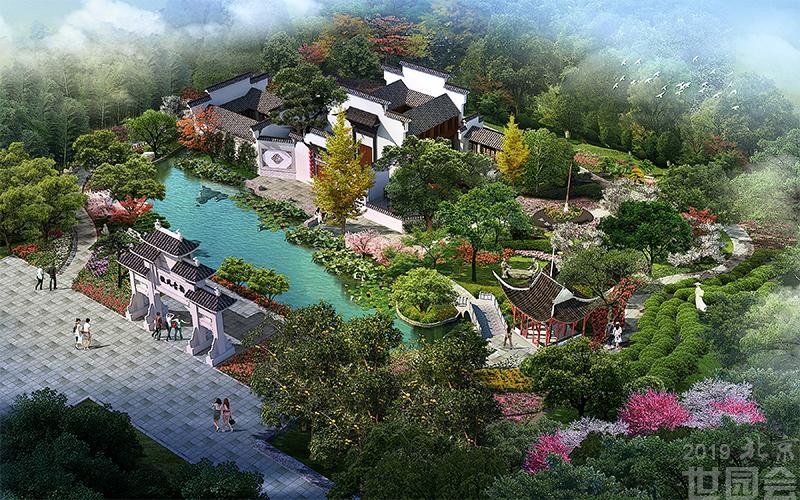

Main Venue Twelve Sights International Gardens Domestic Gardens Corporate Garden Masters’ Garden Specialized Gardens
Activity ServicesRecommended Itineraries Rental Information Retail Outlets Volunteer Service Transport Information
Online Expo Hi-tech Expo5G Sapiential Expo Robotics Internet of Things
Ticket Media CenterAnhui Garden: Ancient Anhui in White Walls and Dark Grey Roof Tiles
When it comes to Anhui, there would probably be such a picture in people’s mind: an ancient village amid a veil of kitchen smoke, embraced by green hills and clear waters, and dotted with white walls, dark grey roof tiles, and horsehead walls. It seems to bring people into an artistic atmosphere of the harmony between man and nature. The Anhui Garden of Beijing Expo 2019 is going to show the world such a picturesque ancient village in Huizhou, Southern Anhui.

In the middle of the Anhui Garden, there is a small building that could have been an ancient village embraced by waters. Along with mountain landscapes on the east and west as well as microtopography and an arbor forest on the northwest, visitors will feel like they are standing in a village nestling against a mountain. Typical Anhui plants in the garden show people around the world what Anhui was like in the ancient times. The garden is composed of three parts: the water gap garden area, the exhibition area for village culture and everyday horticulture, and the field horticulture area. The three make a perfectly-fitting whole, connected by meandering waters and Huizhou-style tourist paths of blue flagstone.
In people's imagination, a beautiful village should be nestling under a mountain, surrounded by waters and faced with a natural shield, and there must be a river or a stream rapidly flowing across the village. At the entrance of the Anhui Garden, the water gap garden will bring this visual enjoyment to visitors. As a unique garden style of ancient Huizhou villages, water gap is known as “China’s civil garden.” The simplicity, nature, and peacefulness of the water gap garden are created with arch bridges, wayside kiosks, mini waterfalls, big trees and bar stone revetments. The garden welcomes visitors with towering Huizhou memorial archways and plants in the shape of what the Chinese call “visitor-greeting pines.”
With the impression of ancient villages as the core, the exhibition area for village culture and everyday horticulture uses the combination of small Huizhou-style buildings to create the atmosphere of ancient villages. The indoor exhibition mainly includes tea culture, medicinal chrysanthemums, Four Treasures of the Study(paper, brush, ink and inkslab), and Anhui operas, as well as representative Anhui handicrafts and horticultural products such as the Three Carving Crafts of Huizhou and Wuhu iron painting etc. On the outside, courtyards and patios show the Anhui-style everyday horticulture with traditional local-grown flowers and potted plants in various forms. The canals running across the buildings give you a glimpse of the living water flowing through every household. The vertical greening on the exterior walls of the buildings, melons, fruits and the vegetable garden depict what life looks like in the village. The field horticulture area is composed of six zones including the Misty Tea Garden, Herbal Garden, Fruit Garden, Garden for Rare Flowers and Plants, Four Treasures of the Study and Bamboo Forest.
In terms of its construction, the Anhui Garden is mainly built with natural ecological materials. The builders make use of construction waste, pavement materials and small daily articles collected from villages of Southern Anhui, such as old bricks and tiles, old flagstones and old stone basins. Meanwhile, new materials and technologies are applied in the small buildings, water piping, irrigation, and lightening.

 Explore new horizons, establish new models. 2019 Beijing Expo is about to closing
Explore new horizons, establish new models. 2019 Beijing Expo is about to closing 7.8 mln tourists visit Beijing horticultural expo
7.8 mln tourists visit Beijing horticultural expo "Macao Day" event held at Beijing horticultural expo
"Macao Day" event held at Beijing horticultural expo Zambia National Day event held at Beijing horticultural expo
Zambia National Day event held at Beijing horticultural expo Forum themed "A Promising Material" held at Beijing horticultural expo
Forum themed "A Promising Material" held at Beijing horticultural expo "Hong Kong Day" event held at Beijing horticultural expo
"Hong Kong Day" event held at Beijing horticultural expo Beijing horticultural expo holds "Ghana Day" event
Beijing horticultural expo holds "Ghana Day" event "Guinea Day" event held at Beijing Int'l Horticultural Exhibition
"Guinea Day" event held at Beijing Int'l Horticultural Exhibition "Britain Day" event held at Beijing horticultural expo
"Britain Day" event held at Beijing horticultural expo "Papua New Guinea Day" event held at Beijing Int'l Horticultural Exhibition
"Papua New Guinea Day" event held at Beijing Int'l Horticultural Exhibition